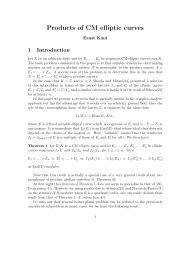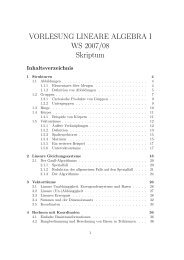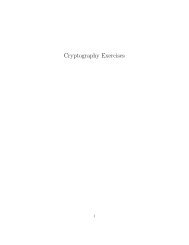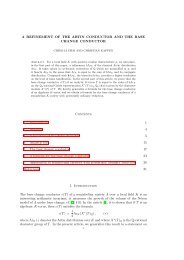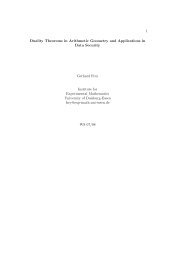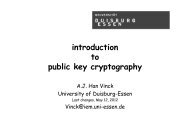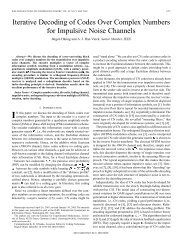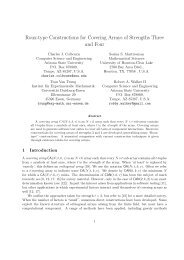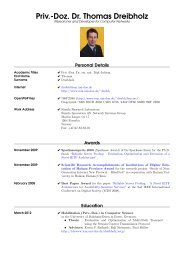UNIFORMLY RIGID SPACES 1. Introduction Let K be a non ...
UNIFORMLY RIGID SPACES 1. Introduction Let K be a non ...
UNIFORMLY RIGID SPACES 1. Introduction Let K be a non ...
Create successful ePaper yourself
Turn your PDF publications into a flip-book with our unique Google optimized e-Paper software.
<strong>UNIFORMLY</strong> <strong>RIGID</strong> <strong>SPACES</strong> 92.2.2. Power-boundedness and topological quasi-nilpotency. <strong>Let</strong> X <strong>be</strong> a semi-affinoidK-space with corresponding semi-affinoid K-algebra A. ByLemma 2.3, A/m is K-finite for m ⊆ A maximal; hence the discrete valuatio<strong>non</strong> K extends uniquely to A/m, so we can define |f(x)| ∈ R ≥0 for anyf ∈ A, x ∈ X.Definition 2.6. An element f ∈ A is called power-bounded if |f(x)| ≤ 1for all x ∈ X. It is called topologically quasi-nilpotent if |f(x)| < 1 for allx ∈ X. We let Å ⊆ A denote the R-subalgebra of power-bounded functions,and we let Ǎ ⊆ Å denote the ideal of topologically quasi-nilpotent functions.For example, S ∈ A = R[[S]] ⊗ R K is topologically quasi-nilpotent, whilethe supremum of the absolute values |S(x)|, with x ranging over X, isequal to <strong>1.</strong> Thus we see that the classical maximum principle fails for semiaffinoidK-algebras. However, the maximum principle holds if we let x varyin the Berkovich spectrum M(A) of A, where A is equipped with its uniqueK-Banach algebra topology, cf. Section 4.Remark 2.7. If A is a <strong>non</strong>-reduced semi-affoind K-algebra, then Å cannot<strong>be</strong> of ff type over R: If f ∈ A is a <strong>non</strong>zero nilpotent function, then f ∈ Å isinfinitely π-divisible in Å, but R-algebras of ff type are π-adically separated.Remark 2.8. If A ⊆ A is an R-model of ff type, then A ⊆ Å, and Ǎ∩A ⊆ Ais the biggest ideal of definition. Indeed, by Lemma 2.1 and its proof, thebiggest ideal of definition of A is given by the Jacobson radical, and hence itsuffices to observe that for any f ∈ A and any x ∈ sSp A with specializationn ⊆ A, we have |f(x)| ≤ 1, where |f(x)| < 1 if and only if f ∈ n. Thishowever is clear from the final statement in Remark 2.5.For the notion of normality for formal R-schemes of locally ff type, we referto the discussion in [10] <strong>1.</strong>2.1, which is based on the fact that R-algebras offf type are excellent. The following result is fundamental:Proposition 2.9. <strong>Let</strong> A <strong>be</strong> a semi-affinoid K-algebra. If A admits a normalR-model of ff type, then this model coincides with Å.Proof. <strong>Let</strong> A <strong>be</strong> a normal R-model of ff type for A. By [11] 7.<strong>1.</strong>9, we mayview A as a subring of the ring of global functions on (Spf A) rig , and by[11] 7.4.1, [12], A coincides with the ring of power-bounded global functionsunder this identification.□Corollary 2.10. <strong>Let</strong> A <strong>be</strong> a semi-affinoid K-algebra, and let A ⊆ A <strong>be</strong> anR-model of ff type; then the inclusion A ⊆ Å is integral. If moreover A isreduced, then this inclusion is finite.Proof. <strong>Let</strong> ϕ: A → B denote the normalization of A. Then ϕ is finite sinceA is excellent, and hence B is of ff type over R. Extension of scalars yieldsan induced homomorphism of semi-affinoid K-algebras ϕ: A → B. Since



